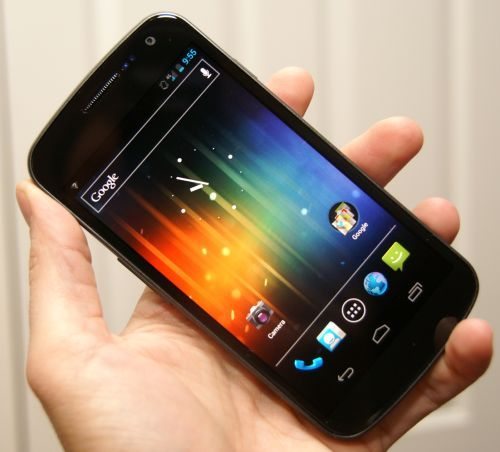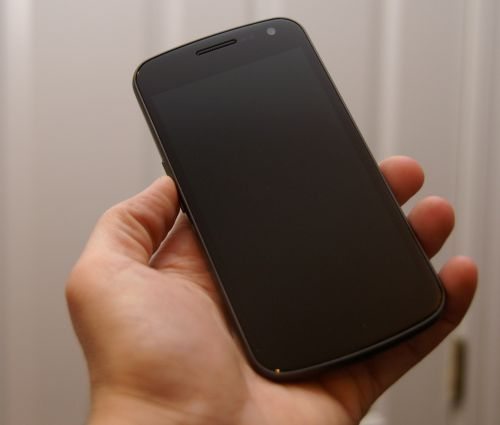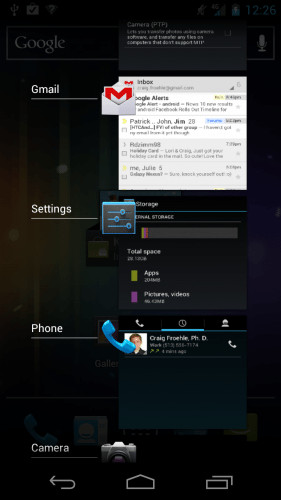 The newest member of Google’s Nexus family of smartphones — the Galaxy Nexus by Samsung — has finally arrived on Verizon with 4G LTE. While Julie will be posting a full, in-depth review here soon, these are my impressions after spending a day with this latest incarnation of Android.
The newest member of Google’s Nexus family of smartphones — the Galaxy Nexus by Samsung — has finally arrived on Verizon with 4G LTE. While Julie will be posting a full, in-depth review here soon, these are my impressions after spending a day with this latest incarnation of Android.
HARDWARE
The Verizon CDMA/LTE version of the Galaxy Nexus (hereafter “VGN”) is a terrific phone, but it’s an evolutionary improvement over other Android phones.
Yes, it has an amazing, curved 4.65″ 720p (720×1280) Super AMOLED display. That’s the same physical size as Sprint’s version of the Samsung Galaxy S II, but it has higher resolution. It has the same resolution as the HTC Rezound’s 4.3″ Super-LCD, but with the deeper blacks and more eye-popping colors that AMOLED offers. Evolutionary.
Yes, it has 32GB of internal storage, but in reality, that’s actually just 28GB of usable space. And, with no microSD slot, that’s all you’ll ever have. The CPU is a dual-core 1.2 GHz TI chip, so it’s just as fast as several other phones out now, but that’s not the 5-core Tegra-3 CPU like some Android tablets are starting to come out with. Regardless, the VGN seemed quite zippy, with only the occasional pause to collect itself (and that it was working on setting up all my Google accounts while doing so might be a legitimate excuse).
The battery is big, but it needs to be because Verizon’s ultra-fast 4G LTE data sucks power like nobody’s business. I’ve not had the phone long enough to make a conclusion about battery life, but I used this thing a LOT and the battery life wasn’t shockingly terrible (unlike, say, the HTC Thunderbolt I spent some time with).
The phone is big, but light….it isn’t incredibly thin (like the Motorola Droid Razr) but still weighs just 4.8 oz. But, because of the girth, you do notice it in your pants pocket. The Nexus S this ain’t.
The fact that the camera only has 5MP will disappoint some, but only until they actually use it. More on that below.
The VGN also has NFC (near-field communications, such as for making wireless payments) and all the other wireless connectivity you’d assume.

Perhaps the thing you notice immediately is that it’s so very monolithic. With no icons or buttons on the front of the phone, it is almost ominous. The notification LED (which is RGB, so it can flash any color) is located in the center of the face below the screen (a clever design reference back to the G1’s trackball, perhaps?).
All told, the hardware seems like a really solid phone upon which to deliver the real treat: Android 4.0.
SOFTWARE
The real story with the Galaxy Nexus is that it offers the very latest version of Android: 4.0, or Ice Cream Sandwich (ICS). Android 4.0 represents a major design departure from previous generations, and it is an effort to meld the phone versions of Android (everything up through 2.3, or Gingerbread) with the tablet version of Android (3.0, or Honeycomb) into a single, unified user experience. While I’ve not yet seen a tablet running ICS, the resolution on the VGN is actually higher than many tablets, so it’s pretty easy to see how it might scale up in size, if not also resolution.
I won’t go into great detail about ICS, but my limited time using it suggests that it’s a VERY nice leap forward in terms of usability. While I don’t personally have (m)any complaints about Gingerbread, Honeycomb is, to put it politely, pretty terrible from a usability perspective. ICS cleans up a lot of the mistakes that Honeycomb includes and seems rather refined and polished, and extends that polish to all the core apps as well.
Sure, some things changed signficantly, like the absence of search and menu capacitive buttons below the screen. Replacing those are on-screen icons. The only problem I had was a milder version of my frustration with Honeycomb…these icons aren’t in the same place on every screen. In some apps, the menu button is in the lower right; in others, it’s in the upper right. Sometimes, I couldn’t find the search function at all, forcing me to head back to Home to do a search. That’s certainly not ideal and, frankly, rather odd given that Google is first and foremost a search company.
One thing that I literally cheered when I saw it was the fact that both notifications and running apps can be discarded/closed by simply swiping them off the screen, a la webOS. Thank you, Matias Duarte!
 Also nice is the fact that a full suite of Google’s official apps comes preloaded on the phone, including: Maps, Gmail, Calendar, Google+, Music, Books, Videos, Android Market, Talk, YouTube, Navigation, G+ Messenger, and Voice Search. No longer do you have to head to the Market immediately to get some of these basic functions on your phone. You still need to grab some Google apps, like Goggles, Street View, and Earth, but it’s a start.
Also nice is the fact that a full suite of Google’s official apps comes preloaded on the phone, including: Maps, Gmail, Calendar, Google+, Music, Books, Videos, Android Market, Talk, YouTube, Navigation, G+ Messenger, and Voice Search. No longer do you have to head to the Market immediately to get some of these basic functions on your phone. You still need to grab some Google apps, like Goggles, Street View, and Earth, but it’s a start.
A feature I assumed would not work very well — and it didn’t — was the new Face Unlock. In a nutshell, the phone uses the front-facing camera to match up your face with the face you told it is you and unlocks the phone. Not only does it take about 3X longer to recognize you than it does to simply do a gesture unlock, it also fails to recognize you fairly often. Depending on lighting, whether or not you’re wearing glasses, how your hair looks, etc., Face Unlock worked for me about 60% of the time…a false-negative rate far too high for me to rely on. But, hey, it might get better, right?
Now, about that camera. One feature that Google was especially proud of on the Galaxy Nexus was the rapid-fire shutter. I was able to take eight 5MP shots in about 2 seconds by quickly tapping the on-screen shutter button. Yes, that’s fast…very fast…maybe even game-changing fast. Photos were of good quality in decent light; low light makes for some tortured images. Some samples:



All told, I like ICS very much and am quite excited that Android finally seems to be adding some design polish to what is fundamentally a very strong and customizable operating system.
SERVICE
The last piece of the puzzle is cellular service. I couldn’t do extensive testing, but the Galaxy Nexus seemed to be able to hold onto a signal reasonably well with good call audio quality. Speakerphone volume seemed acceptably loud, but not great tonal quality…par for the course with most phones today, it seems.
Data service is much more noteworthy. Verizon’s 4G LTE service, where you can find it (an increasingly long list of US cities), is very, very fast. So fast that you might be tempted to stream a lot of videos and music, burning through your bandwidth allotment faster than you thought possible (at the moment, Verizon is offering 2GB of 3G data and 2GB of 4G data for the 2GB pricing tier). So be careful…and use Wi-Fi when you can.
SUMMARY
I like! If you need a new phone, have $300 to spend (or $650 without contract renewal), and Verizon is your carrier, the Galaxy Nexus could easily be your best option. If we knew that the Droid Razr was getting an upgrade to ICS in the very near future, it could be a toss-up — the Razr offers a very different hardware proposition than the Galaxy Nexus does.
But, as of today, only one phone on the Can-You-Hear-Me-Now Network comes with Android 4.0 out of the box. Thankfully, it happens to be a really nice phone.



Gadgeteer Comment Policy - Please read before commenting
I am very impressed with this phone, can’t wait to see Julie’s full review on this phone…. I am really considering purchasing one but I am going to wait until I see the review and then go to Verizon store and play with the phone some. I really like the fact that it does not have all the VZW bloatware.
Which screen is really “bigger”? My old 4.3″ that does NOT take up any valuable screen-space with the bottom buttons.
Or a 4″ screen, that puts buttons on it and then claims it’s kind of like 4.6″?
Toss up with the Razr? Evolutionary? Get to day 2 and do a rewrite.
Helen, if you don’t include the button area, the screen is actually about 4.38″. But, there are times when the buttons aren’t there (e.g., watching video) and you get to use the full resolution and size of the display.
Thanks for the nice review, Craig, I’ve avoided others because they were huge, and this was easily digestible, just like an ice cream sandwhich, hahah!
Phil Nickenson alluded to other carriers having a version of this phone sooner rather than later -as in maybe even 1st quarter 2012. So I’m hoping that we see a Sprint version, at which point I can at least consider selling my EVO 3D and picking up one of these.
One question about ICS. I use a third-party launcher (Go Launcher EX) for a number of the extended capabilities that Sense 3.0 doesn’t have, so was wondering if ICS has any of these. Specifically, scrollable widgets and resizable widgets. I’m pretty sure ICS has the latter since I think I heard that Honeycomb did, but what about ICS? This phone does use that vs. Touchwiz or something else like that, right? Also, are you still limited to just 7 screens? And I seem to remember someone making a big deal about folders in ICS, but from what I know this has been around for a long time, so what’s the deal? Is it within the app drawer? If so, I can already do this with Go Launcher. Is it just that folders are more deeply embedded into the OS, so all apps have some innate folder association?
Levi, in ICS, you can use folders in app drawer (the little area right above the three icons, right?) as well as on the home screens. They work well…but I still think some 3rd-party apps do it better. And that’s OK, IMO. ICS does have resizable widgets, but not all widgets are resizable, kapish? And yes, there are scrollable widgets, too, but not all widgets are scrollable.
Craig- did you find out how to change the resolution of the pictures you’re taking? The settings menu within the camera app allows you to turn geolocation (“Store location”) on or off, and then shows picture size “< 5M Pixels", but no options to change. I downloaded a few pics i took and did the megapixel math, and i'm only coming out with 1536P*2048P=3.15MP. Thanks for any help you can give!
EDIT: Pictures actually are coming out at 5MP; Google+ was shrinking them to 3 upon upload. Still, I can’t find the option to select what size I want, like back in the Gingerbread days.
Sure, I understand that not all widgets do scrolling, but are you saying that some widgets which otherwise might have scrolling capability in Go Launcher don’t in ICS, or are you saying that anything that has that scrolling capacity will scroll in ICS, just not the ones that don’t have that as part of the widget’s features?
Regarding the folders in the app drawer, can you then make shortcuts to those folders on your main screens, in a similar way that you can with something like Folder Organizer? I’m wondering if a tool like Folder Organizer will still be better since you are able to back up that folder info, whereas on ICS presumably if you switch phones there’s no way to save that. I know there are backup apps, but I wonder if they would actually save such info. Maybe in the future, but probably not quite yet, given how new ICS is. Plus folder organizer actually alerts you whenever you download a new app that you should put it in a folder, which is a nice way to make sure all your apps are categorized. I just wish you could sync these various foldering methods with each other so that you didn’t have to duplicate effort, or even pick just one to use and thus lose the functionality of the other…
I have resisted getting a personal phone for nearly 5 yrs now. I’ve been using my company issued BB. The combination of the Galaxy Nexus (720px1280p), Android 4.0 and Verizon 4G LTE convinced me to take the leap back into carrying both a personal phone and the accompanying monthly service charges.
All I can say is “WOW”, I really picked to right time to re-connected. The display is gourgeous, videos in HD as stunning and using my Bluetooth headphones with sites like VEVO and Jango is just monstorously entertaining. On importing my BB contact list, Google+ (or some google service) started associating pictures with some of my contacts. Tie into my gmail account was seemless after logging into my google account. Very clean – Very glad I leapt into the 21st century. I’m still learning about Android ICS but I am thrilled with my decision.
I am waiting to get my Galaxy Nexus delivered. Verizon is actually doing a special where you get 4GB of data for the 2GB price. I’ve heard so much good about this phone. The screen, the processor, everything! I stream a lot so the screen and LTE should be good for streaming and downloading. I currently use the DISH Remote Access app from DISH Network on my iPhone and it is good, but 3G is a bit slow. From my experience working at DISH and using the app, I find that streaming live TV and recorded shows from my receiver requires a bit of speed and the iPhone rarely has it. I am definitely looking forward to streaming using LTE! I can’t wait for my phone to get here!
FYI, from what I’ve read, the overseas GSM flavor of this phone is 4.8 ounces (135 grams) while the VGN is 5.3 ounces (150 grams).
Nice review. Any comments on battery life? I’ve read that LTE is significantly more power hungry compared to 3G. What are your thoughts on the absense of user expandable memory (a la Droid RAZR and HTC Rezound)? Also some have reported the crippling of NFC by Verizon which may make this phone undeserving of the Galaxy class designation.
how de battery life n what abut de camara how much megapixal is it n is better then galaxy S2 plz gide me as i m using a galaxy S2 n want some yhing better
I am concerned about phones with no SD card, particularly if the phone craps out you have to turn it in with your info on the onboard memory. Someone could power the circuits and retrieve the memory contents. With the SD card, you simply remove it and no info is left behind. Strictly from a security standpoint (sometimes you may want to eject/swap the SD card in the event you for some reason have to part with your phone.
If this phone battery can last through one day, then it will be a good phone. Currently it can’t even last through 4 hours of normal use with original battery
I resort in using an extended battery to lengthen the power life of this phone. So far the Qcell extended battery last me through a day which is an acceptable usage
http://www.amazon.com/QCell-Verizon-Samsung-Extended-Compatible/dp/B00746TQVM/ref=sr_1_1?ie=UTF8&qid=1333084783&sr=8-1